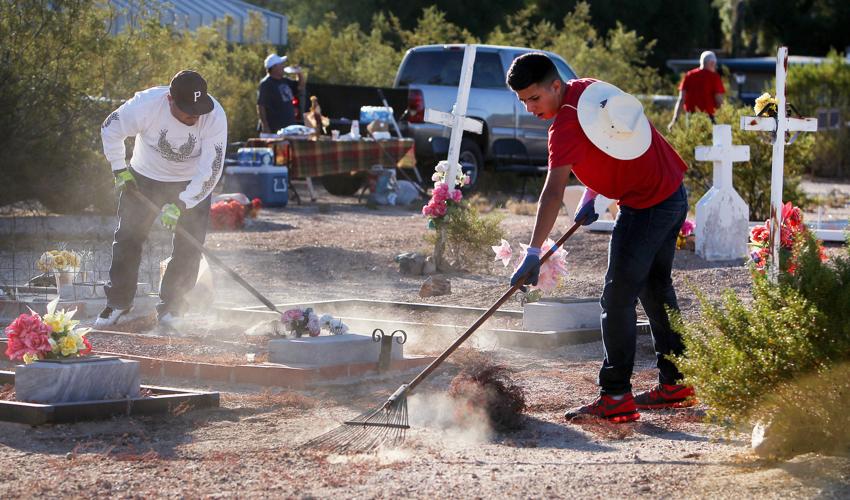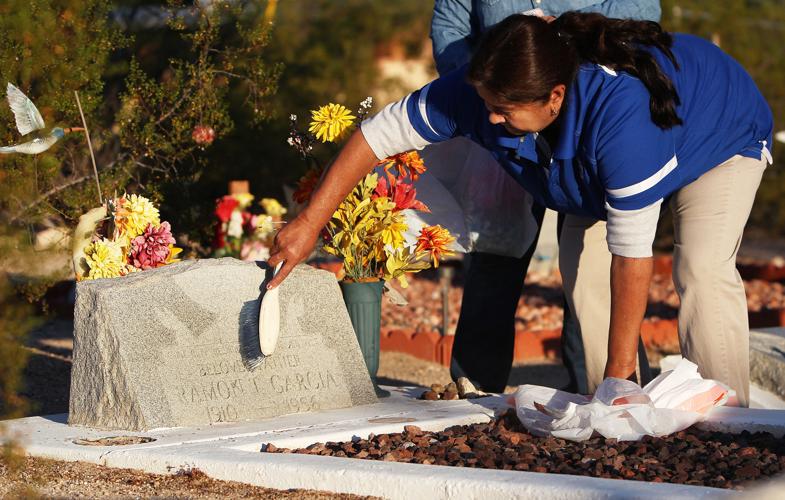When Benny Ochoa visits his relatives at the Fort Lowell Cemetery, it’s easy to swing by a store to grab flowers to place on the graves.
But it hasn’t always been that way.
To celebrate Día de los Muertos in his boyhood, Ochoa’s family would trek to the Fort Lowell Cemetery, joining others to place flowers, light candles and tidy gravesites. On special occasions, the grandmothers made paper flowers, he recalled.
“You couldn’t go to a Circle K and get flowers like now,” he said. “If there were no flowers in the desert, we were out of luck and would go over there and just clean.”
And while families such as the Ochoas have long recognized Día de los Muertos here, this is the second year the cemetery is hosting a communal gathering, organized by the Old Fort Lowell Neighborhood Association Inc. on Saturday, Nov. 5.
“If it’s more formal and we get the word spread out, it enables us to touch base with relatives we don’t normally see and reminisce,” said Lisa Bravo, a member of the neighborhood association’s cemetery committee. Bravo has relatives on her mother’s side buried there.
Tucked between an office complex and houses, this acre of desert landscape is the final resting place for many of the families who settled in the area after the abandonment of Fort Lowell. They built the village of El Fuerte and came to be known as Los Fuerteños. Only their descendants can be buried in the cemetery.
“My grandparents on my father’s side came by wagon from Ures, Mexico, close to Hermosillo,” Ochoa, 77, said. “They used to farm there with the water from the Rillito, and that’s where my dad was born.”
Although Ochoa is no longer involved in the neighborhood association committee that oversees the cemetery, he spent years walking the grounds, hauling trash and pulling weeds. Still, he tends to the graves of his family.
The community gathering at this cemetery is no big festival. Rather it is a time of community reflection. Last year, it drew about 20 people to pray and think “on this life and the next one,” said Manuel Ramos, a member of the cemetery committee. Several altars will facilitate that contemplation.
Bravo, who visited the cemetery for last year’s Día de los Muertos celebration, said it was an evening of decorating graves and praying alone and with others.
“The day for me is bittersweet because you reminisce about all of your loved ones that have departed and left us,” she said. “It’s a lot of reflection and memories and smiles.”
Ochoa said that according to his father, the people of El Fuerte began burying people in the cemetery in the late 1800s on a plot of land made available to the community by a private owner. In 1997, owner Jean Dun Porter gave the land to the neighborhood association.
No one knows the exact age of the cemetery. It could be even older than Ochoa’s estimation, said Caren Groesbeck, curatorial aid for the Arizona Historical Society.
On Saturday, about 20 volunteers gathered to clean up the cemetery in advance of Día de los Muertos. Though many of the descendants of Los Fuerteños no longer live in the neighborhood, the cemetery binds them together.
When Groesbeck moved to Tucson from Nevada about 15 years ago, it was her first time living in the city steeped with her family’s history. Through her mother’s side, her relatives were employed by the military to help with the decommissioning of Fort Lowell in 1891.
Moving to Tucson allowed her to reconnect with her family and its history.
“When I moved here, I was like, are you family? Are you family?” she said, laughing.
A former member of the neighborhood association and cemetery committee, she, too, has family buried there.
“It’s a little gem,” she said. “No one knows about it. It’s a one-acre parcel that holds just a lot of history and culture, and it links a community together.”





